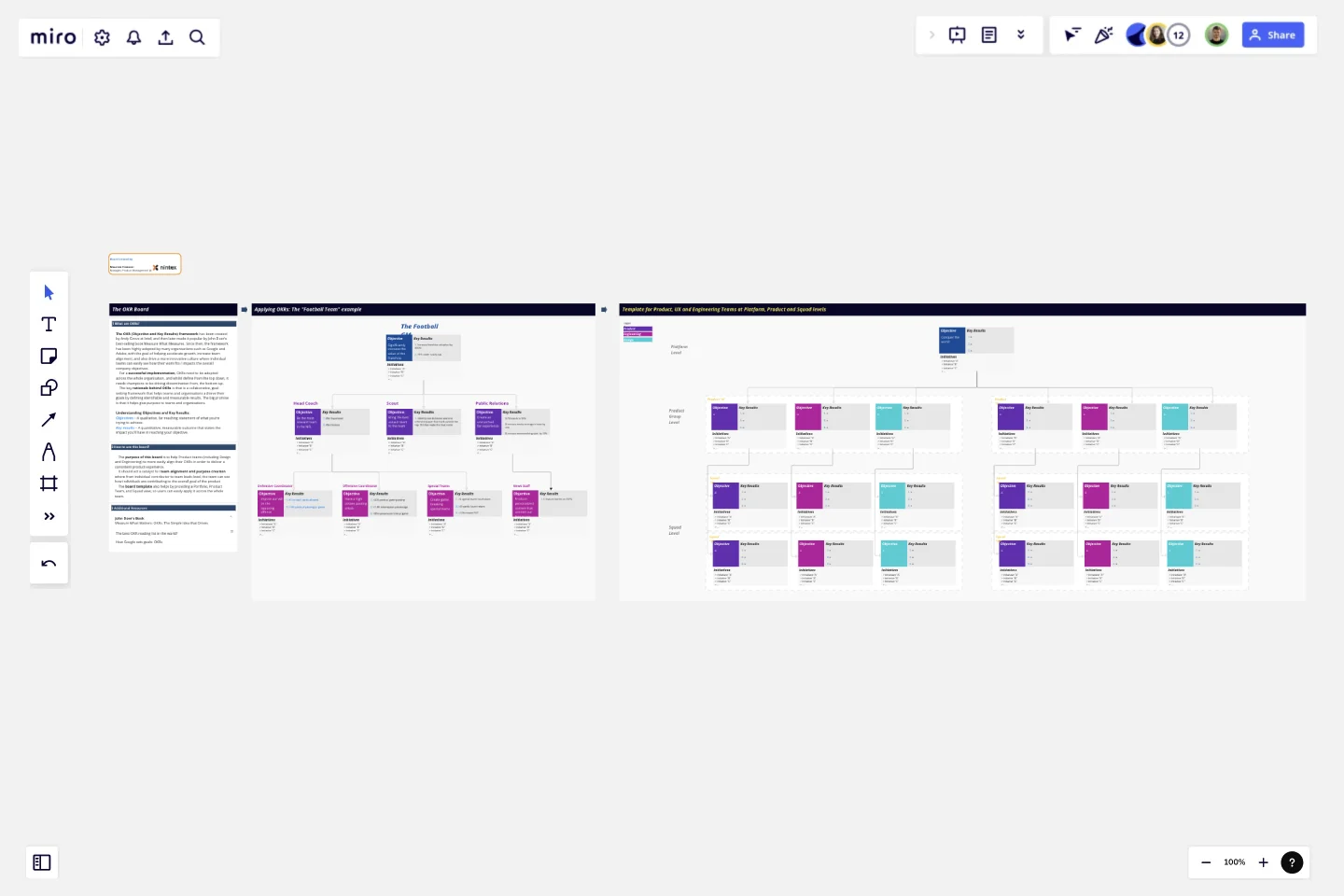OKR Board for Product, UX and Engineering Teams
The OKR (Objective and Key Results) framework has been created by Andy Grove at Intel, and then later made it popular by John Doer's best-selling book Measure What Measures.
The framework has been highly adopted by many organisations such as Google and Adobe, with the goal of helping accelerate growth, increase team alignment, and also drive a more innovative culture where individual teams can easily see how their work fits / impacts the overall company objectives.
For a successful implementation, OKRs need to be adopted across the whole organisation, and whilst define from the top down, it needs champions to be driving dissemination from, the bottom up.
The key rationale behind OKRs is that is a collaborative, goal-setting framework that helps teams and organisations achieve their goals by defining identifiable and measurable results. The big promise is that it helps give purpose to teams and organisations.
The purpose of this board is to help Product teams (including Design and Engineering) to more easily align their OKRs in order to deliver a consistent product experience.
It should act a catalyst for team alignment and purpose creation where from individual contributor to team leads level, the team can see how individuals are contributing to the overall goal of the product.
The board template also helps by providing a Portfolio, Product Team, and Squad view, so users can easily apply it across the whole team.
This template was created by Mauricio Franzoni.
Get started with this template right now.
Value Stream Mapping Template
Works best for:
Project Management, Strategic Planning, Mapping
A value stream map can help you refocus your business on steps that actually provide value to your customers, cutting out wasteful and inefficient processes. With this template, you and your process team can collaborate on a value stream map today.
Service Blueprint by Liz Possee Corthell
Works best for:
Service Blueprint
Enhance your service design with the Service Blueprint Canvas. This template helps you visualize and analyze the entire service process, from front-stage customer interactions to back-stage support activities. Identify pain points, optimize workflows, and improve customer experiences. Ideal for service designers, managers, and teams focused on delivering exceptional service. The blueprint provides a comprehensive view, facilitating better communication and strategic planning.
Product Management - Product Flow
Works best for:
Product Management, Planning
Product Management - Product Flow template enables product managers to visualize and streamline product development processes. By mapping out key stages, tasks, and dependencies, this template enhances workflow transparency and coordination. With features for identifying bottlenecks and optimizing resource allocation, it empowers teams to improve efficiency and accelerate product delivery. This template serves as a valuable tool for ensuring smooth product development and launch processes, ultimately driving better outcomes.
Improve Any Product - Product Management
Works best for:
Product Management, Planning
Improve Any Product - Product Management template provides a structured framework for enhancing product quality and performance. By analyzing customer feedback, identifying improvement areas, and implementing iterative enhancements, this template empowers product managers to optimize product features and functionalities. With sections for prioritizing enhancements and tracking progress, it facilitates continuous improvement efforts, ensuring that products meet evolving customer needs and market demands.
666 Roadmap Template
Works best for:
Strategic Planning, Product Management
For most companies, especially startups, it’s important to keep two perspectives in mind when planning for the future: your plan and your vision. Your plan is a close-up view of what you want to accomplish in the near future, while your vision provides a zoomed-out view of what you hope to accomplish in the long term. The 666 Roadmap encourages you to plan for the future by thinking about the next 6 years, 6 months, and 6 weeks. Use this roadmap to strategize, think about what you want to build, and focus on a concrete plan for the upcoming quarter.
Scope of Work Template
Works best for:
Project management, Planning
The Scope of Work Template from Miro brings structure, clarity, and efficiency to project planning. It's more than just a template—it's an adaptable and dynamic platform that adapts to your unique project needs. Join thousands of satisfied users and make the Scope of Work Template a part of your project management toolkit.
